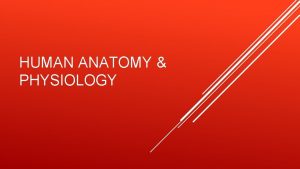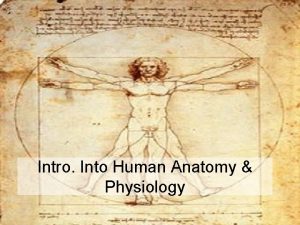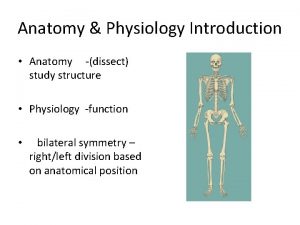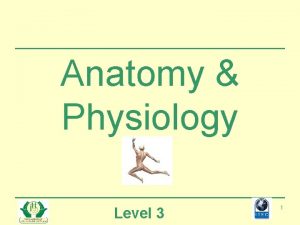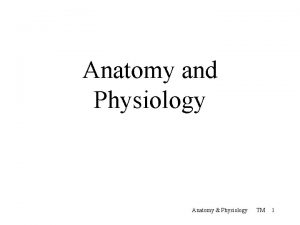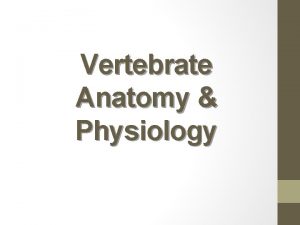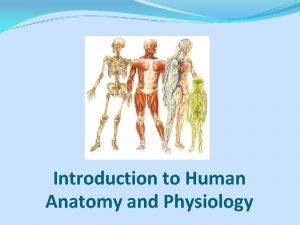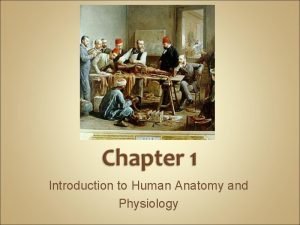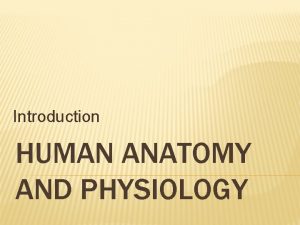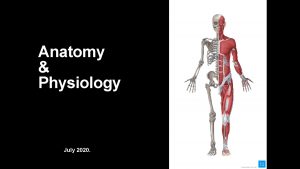Introduction to Human Anatomy and Physiology In 2007




























- Slides: 28

Introduction to Human Anatomy and Physiology

In 2007, Kati Mori took part in the London Marathon – her fourth, and the hottest on record, with temperatures peaking at 75 F. Conscious of the repeated advice to maintain fluid intake, she took frequent drinks at the water stations along the route. By the 18 th mile, Kati felt bad but was determined to finish, Near the end, she needed help from other runners to stay upright; hours later she was in the hospital, suffering from severe diarrhea, headache, vomiting and increasing confusion, with her legs endlessly mimicking a running motion. “I thought I was still in the marathon, ” she says. Essential Question: What happened to Kati Mori at the London Marathon?

Anatomy – the structure of body parts (also called Morphology) Physiology – the function of the body parts, what they do and how they do it The structure determines the function.

Characteristics of Living Things 1. Movement - self initiated change in position, motion of internal parts 2. Responsiveness - Ability to sense changes and react to them 3. Growth - increase in body size 4. Reproduction - Parents produce offspring / passing DNA to new individuals 5. Respiration - Obtaining oxygen (O 2), using it to release energy from food substances, and getting rid of wastes

6. Digestion - Chemically changing (breaking down) food substances, and getting rid of wastes 7. Absorption - Passage of Digested products (food substances) through membranes and into body fluids 8. Circulation - Movement of substances throughout the body 9. Assimilation - Changing absorbed substances into chemically different substances 10. Excretion - Removal of wastes

Why do beans make you fart? Which life processes we discussed are shown in this short video?

Review the list of life processes and consider Kati Mori’s symptoms. Choose three of the processes that you think might be related.

Metabolism = all the chemical changes that occur in the body to maintain life. Ultimately all of these processes require ENERGY How do we obtain energy?

Bodily needs = food, oxygen, water, heat (How long can you live without these? )

Homeostasis = tendency of the body to maintain a stable, balanced, internal environment. “Sameness” Energy is required to keep the body in working order. Where does this energy come from?

How does a negative feedback loop maintain homeostasis? Receptors – detect certain environmental parameters within the body such as temperature, information is relayed to the brain Set point – the normal range that an environmental parameter is to be controlled Effectors – muscle or glands that respond to deviation from the set point. Glands might initiate sweating to cool the body back to its set point.

How does a positive feedback loop maintain homeostasis? As the baby suckles on the nipple there is a nerve response into the spinal cord and up to the brain, which then stimulates the pituitary gland to produce more prolactin to produce more milk Positive feedback loops amplify or increase the occurrence of events.

When Kati arrived at the hospital and doctors began to collect information, they discovered that she weighed 128 lbs. Oddly, when she checked in to the race, she weighed 126 lbs. The doctor suggests that Kati might have “hyponatremia. ” What do you think that is?

In cases of water intoxication, it is extreme hyponatremia that can ultimately cause coma and death. The doctor orders a drug that increases urination. Kati is able to clear the extra water from her body and recovers. How does Kati’s story relate to HOMEOSTASIS? Which of the 10 life processes were compromised in Kati’s situation?


●Axial Portion - head, neck, trunk ●Appendicular Portion - arms & legs 1. Several body cavities & Layers of membranes within cavities 2. Variety of organs and organ systems within cavities (VISCERA = internal organs. "Visceral organs")

Just for fun! EVISCERATE Popular in horror movies and games Photo Source: https: //www. flickr. com/photos/pietroizzo/7478162336/in/photostream/

Body Cavities Dorsal = back side Ventral = front side Thoracic = chest (heart, trachea, lungs. . ) Abdomen = stomach area (spleen, intestines) Pelvic = lower abdomen (bladder, reproductive organs) DIAPHRAGM: Separates the thoracic and pelvic region

It's easier to visualize the body cavities on pictures. Label the body cavities – Best Attempts in PENCIL!



MEMBRANES Serous Membrane - two layers, covers organs Outer layer = parietal Inner layer = visceral (lines the organs) Serous fluid – lubricating fluid

Other Membranes Pleura = lungs Pericardium = heart Peritoneum = organs (abdominopelvic region)

Visceral and Parietal always mean the same thing. Visceral points toward the guts Parietal points toward the outside Visceral Pleura LUNGS Parietal Pleura Visceral Pericardium HEART Parietal Pericardium Visceral Peritoneum Parietal Peritoneum INTESTINES

1. Integumentary 2. Skeletal 3. Muscular 4. Nervous Organ Systems How does each help maintain homeostasis? 5. Endocrine 6. Digestive 7. Circulatory 8. Lymphatic 8. Urinary 9. Reproductive Homework if not completed in class: Organ Systems Concept Map

Anatomical Terminology Anatomical Position = standing erect, face forward, arms at side, palms facing forward *Study and learn the following terms* 1. Superior 2. Inferior 3. Anterior 4. Posterior 5. Medial 6. Lateral 7. Proximal 8. Distal 9. Superficial 10. Deep

A really sharp pane of glass fell on this unfortunate character. From the movie “Thirteen Ghosts” - What kind of cut is this?

What kind of cut is this?
 Chapter 1 introduction to human anatomy and physiology
Chapter 1 introduction to human anatomy and physiology Anterior posterior distal proximal
Anterior posterior distal proximal Human anatomy and physiology seventh edition marieb
Human anatomy and physiology seventh edition marieb Holes essential of human anatomy and physiology
Holes essential of human anatomy and physiology Chapter 2 human reproductive anatomy and physiology
Chapter 2 human reproductive anatomy and physiology Uterus perimetrium
Uterus perimetrium Cranial cephalic
Cranial cephalic Human anatomy & physiology edition 9
Human anatomy & physiology edition 9 Anatomy of upper respiratory tract
Anatomy of upper respiratory tract Tattoo anatomy and physiology
Tattoo anatomy and physiology Science olympiad anatomy and physiology
Science olympiad anatomy and physiology Imperfect flowers examples
Imperfect flowers examples Anatomy and physiology of bone
Anatomy and physiology of bone Anatomy and physiology of gastritis
Anatomy and physiology of gastritis Cantlie line
Cantlie line Epigastric region
Epigastric region Difference between anatomy and physiology
Difference between anatomy and physiology Cytoplasmic granules
Cytoplasmic granules Chapter 14 anatomy and physiology
Chapter 14 anatomy and physiology Http://anatomy and physiology
Http://anatomy and physiology Appendicitis anatomy and physiology
Appendicitis anatomy and physiology Aohs foundations of anatomy and physiology 1
Aohs foundations of anatomy and physiology 1 Aohs foundations of anatomy and physiology 1
Aohs foundations of anatomy and physiology 1 Anatomical planes
Anatomical planes Anatomy and physiology chapter 8 special senses
Anatomy and physiology chapter 8 special senses Chapter 13 anatomy and physiology of pregnancy
Chapter 13 anatomy and physiology of pregnancy Unit 26 agriscience
Unit 26 agriscience Science olympiad anatomy and physiology 2020 cheat sheet
Science olympiad anatomy and physiology 2020 cheat sheet Anatomy and physiology chapter 2
Anatomy and physiology chapter 2

































